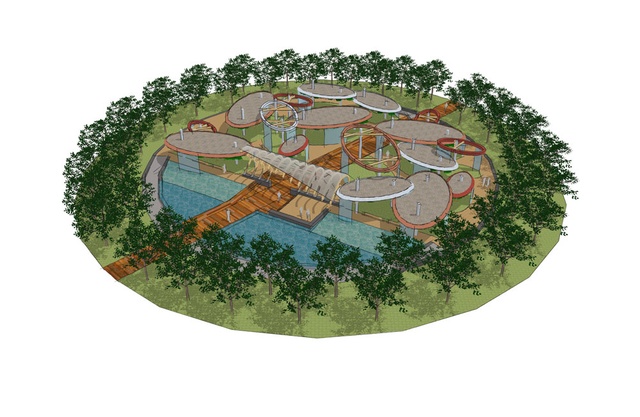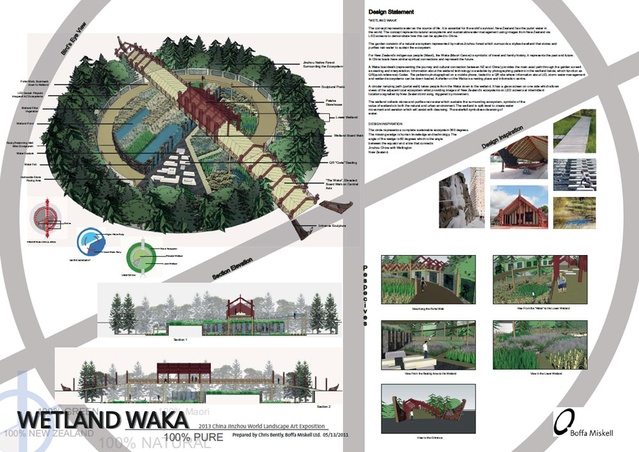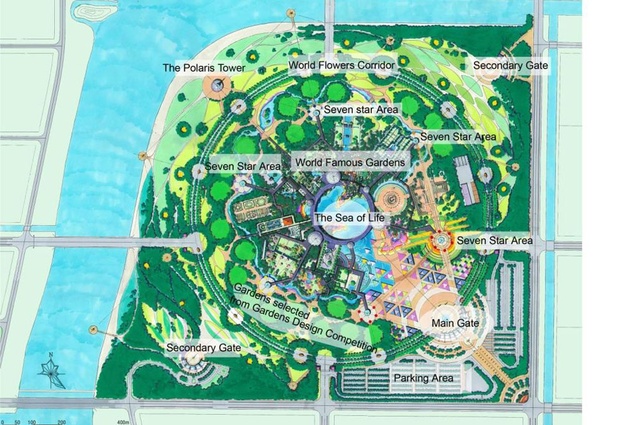Three New Zealand landscape architecture firms earn success in Jinzhou
Three landscape architecture firms – Bespoke Landscape Architects, Boffa Miskell and Prorata Landscape Architecture – have had designs accepted for the 2013 China Jinzhou World Landscape Architecture Exposition. The designers explain their concepts below.
In February 2011, the International Federation of Landscape Architects, in association with Jinzhou City and JCOM China announced a design competition for garden spaces within the proposed 2013 China Jinzhou World Landscape Art Exposition. The main theme of the Expo is “The World is a Garden”, a theme reflecting the idea that landscape architecture and garden art are among the most pleasing aspects of human existence, on an almost spiritual level, for all people, everywhere. Via a registration of interest process, four New Zealand landscape architects were selected to submit concept designs, and three – Boffa Miskell, Prorata Landscape Architecture, and Bespoke Landscape Architects – were successful in joining a total of 20 designers around the world to have their designs constructed within the Jinzhou Exposition site. The designs are centred on the competition theme, but also had to relate to the given designers region, in the case of New Zealand landscape architects – Oceania.
Island Nations Downunder – A Common Meeting Place by the Sea by Bespoke Landscape Architects.
Our concept proposition focuses on the Oceania region, in particular it’s unique and varied composition, being made up of thousands of islands and warmly referred to as ‘downunder’. Although the nations vary greatly in their size, culture, history and demographics, there is a common bond in our link to the coast and the sea. The result is a contemporary, yet tranquil garden which explores several themes centred around this common link.
Islands: Strong elliptical forms, in bold colours, signify the islands and these are held above the ground on pole structures – a play on the perceived ‘downunder’ position of the region. Reinforcing this idea, planting is installed beneath many of these islands and water cascades down from above, as if dropping by gravity from the northern hemisphere. The island ellipses also form more open structures, similar in appearance to island atolls, offering informal places to rest, relax and enjoy the garden.
Ground plane: The island forms are reflected on the ground plane by simple grassed mounds. The contrast of these to the planting above allude to the coming together of the indigenous and western peoples. The lawn seen as the changing perception of the land to production and development by western immigrants that occurred across so many of the nations. Surrounding the grassed mounds a crushed aggregate or sand surface provides the paths for users to navigate their way through the islands.
Pavilion: Inspired by the meeting house, Wharenui or Fale, combined with the natural form of a wave, our pavilion structure provides the place in the garden where people may come together by the water’s edge. A large shallow water body with a cascading edge is formed to signify the sea. As a people in Oceania this is our common space, our playground, our means of transport, our livelihood and in many ways our garden. We envisage the use of the building as predominantly a gathering and contemplative space but also offering the opportunity to present collections by Oceania artists or as a performance space.
Boardwalk: The proposed location of the garden is in the centre of the Oceania area, deliberately positioned on a strong axis and adjacent to a planned body of water. Aligned to this axis and forming a strong link through the garden is a timber boardwalk structure. The design and form of the structure signifies a canoe or Waka – historically so important in the settlement and journey of the first people throughout Oceania.

Boffa Miskell – Wetland Waka
Chris Bentley, manager of Boffa Miskell’s project office in Shanghai, says the Boffa Miskell entry was the result of a company-wide collaborative design exercise.
“It was a great opportunity for the landscape architects in our four New Zealand offices and our Shanghai office to come up with ideas. The inspiration for the initial concept came from Richard Tyler, a landscape architect in our Auckland office and was developed in the Shanghai office.”
The concept represents water as the source of life. It is essential for the world’s survival. New Zealand has the purist water in the world. The concept represents natural ecosystems and sustainable water management using images from New Zealand via LED screens to demonstrate how this can be applied to China. The garden consists of a natural ecosystem represented by native Jinzhou forest which surrounds a stylised wetland that stores and purifies rain water to sustain the ecosystem. For New Zealand’s indigenous people (Maori), the Waka (Maori Canoe) is symbolic of travel and family history; it represents the past and future.
In China, boats have similar spiritual connections and represent the future. A Waka boardwalk (representing the journey and cultural connection between NZ and China) provides the main axial path through the garden as well as seating and interpretation. Information about the wetland technology is available by photographing patterns in the wetland below, which function as QR (quick reference) codes. The pattern is photographed on a mobile phone, texted to a QR site where information about LID, storm water management and wetland ecosystems can be down loaded.
A shelter on the Waka is a resting place and information centre. A circular ramping path (portal walk) takes people from the Waka down to the wetland. It has a glass screen on one side which allows views of the adjacent local ecosystem whist providing images of New Zealand’s ecosystems on LED screens at intermittent locations signalled by New Zealand bird song, triggered by movement. The wetland collects stores and purifies rain water which sustains the surrounding ecosystem, symbolic of the value of wetlands in both the natural and urban environment. The wetland is split level to create water movement and aeration which will assist with cleansing. The waterfall symbolises cleansing of water. The circle represents a complete sustainable ecosystem 360 degrees. The missing wedge is human knowledge and technology. The angle of the wedge is 60 degrees which is the angle between the equator and a line that connects Jinzhou, China with Wellington, New Zealand.

Prorata Landscape Architecture Aotearoa – Land of the Long White Cloud
This design located as part of the Oceania Garden area within the Expo site interprets the theme of voyaging, physical landform of Aotearoa, and its link to Polynesia, through Maori mythology in a contemporary setting. Approaching the space, the peaked lawn landforms recall volcanic hotspot activity and the physical horizontal form typical of Aotearoa when viewed from sea. The vertical poles and PVC sail hovering above these lawn peaks recall the separation of Ranginui, the Sky father, from Papatuanuku, the Earth Mother, by Tane Mahuta. It also represents a long cloud form.
At the core is a sunken garden accessible by way of a abstract form of vessel or ‘Waka’, which was the key mode of transport for past migration as well as used for travel and food gathering. The external steel of the building coloured red, a sacred colour of ochre soil said to be the blood of the sinews that bound Rangi and Papa together cut by another son ‘Tu matauenga’ - ‘The God of War. Inside this concave building shall be contemporary imagery of Aotearoa on LED Screens and further contemporary motif via way of panelling on inside walls and entrance.
The steel concave building transports the viewer down to existing site ground water level to reveal an internal garden space with a mixture of covered coastal plantings native to Bohai Sea, timber boardwalk and more vertical poles. Central to the sunken garden is a contemporary Pou Whenua (symbolic pole) which shall interpret the importance of Tangaroa – God of the Seas and the inter-relationship with the sea for food supply, respect and environmental stewardship for future generations. All is located at ground water level also to expose and recognise the existing coastal landform and use of the expo site pre development.
Around the edges of this garden shall be contemporary weaving panels (tukutuku) visually recalling further links to Aotearoa. Stormwater management shall be by way of retention for irrigation of plantings and ground water recharge where practically possible. All materials shall be from managed forest resources for timber poles and panelling, steel from local industry supply, all lighting and imagery screens to be LED technology and mounded lawn cones from excess soil from other parts of the expo site development. All planting shall be eco-sourced from managed resources in China.












